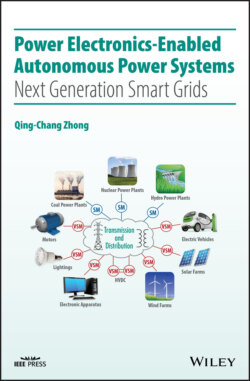Читать книгу Power Electronics-Enabled Autonomous Power Systems - Qing-Chang Zhong - Страница 20
1.3.2 Smart Grids
ОглавлениеThe large‐scale utilization of DERs, including renewables, EVs and energy storage systems, brings unprecedented challenges to grid stability, reliability, security, and resiliency (Zhong and Hornik 2013). The conventional centralized control paradigm is no longer feasible for power systems with millions of relatively small and distributed generators.
Adding an ICT system into power systems, hence the birth of smart grids, has emerged as a potential solution to make power systems friendlier to the environment as well as more efficient (Amin 2008; Amin and Wollenberg 2005). The main characteristics of smart grids in comparison to today's grids are shown in the second and the third columns of Table 1.1, with a prominent intention to address all problems via adding an ICT system. More details about smart grids can be found from the literature, e.g. (Amin and Wollenberg 2005; DOE 2009; Ekanayake et al. 2012; Fang et al. 2012; Farhangi 2010; Momoh 2012).
Table 1.1 Comparison of today's grids, smart grids, and next‐generation smart grids.
| Characteristic | Today's grid | Smart grid | Next‐generation smart grid |
| Role of ICT | Constantly growing | Tendency to introduce bidirectional ICT into every part and corner of power systems | Unidirectional ICT for monitoring and management but not for control to prevent cyber‐attacks and single point of failures |
| Load participation in system regulation | Limited, non‐participative (passive) | Binary (ON/OFF) demand responses enabled by ICT | Autonomous, continuous demand responses for fully active regulation of frequency and voltage, without the need of ICT |
| Generation mix and DER integration | Dominated by central generation with limited but growing current‐controlled DER units | Diversifying, with mostly current‐controlled DERs, strong tendency of relying on ICT | DER dominated or even 100% renewable with grid‐friendly, compatible DERs, autonomous system regulation without the need of ICT |
| Cascading failures and blackouts | Inherent, systemic flaw | Significantly reduced number of incidents enabled by ICT but catastrophic when it happens | Built‐in capability of preventing local faults from cascading into wide‐area blackouts |
| Resiliency against faults and natural disaster | Vulnerable to faults, natural disasters, and the resulting cascading failures | Significant improvement enabled by ICT | Fully autonomous, mutually supported, fast recovery, reduced burden on utilities, without the need of ICT |
| Cyber‐security | Vulnerable to malicious cyber‐attacks | Significantly improved but still a systemic flaw | No access to the system through ICT; no more cyber‐attacks to power systems |
| Power quality | Focus on outages, sometimes low power quality | A priority with a variety of quality/price options | Built‐in control flexibility and functions to fundamentally reduce faults and outages and improve voltage quality |
| System‐wide efficiency | Limited means for improvement | Significant improvement enabled by ICT but causing data explosion and ever‐increasing complexity | Organic and harmonious operation underpinned by optimally designed components and system architecture |
